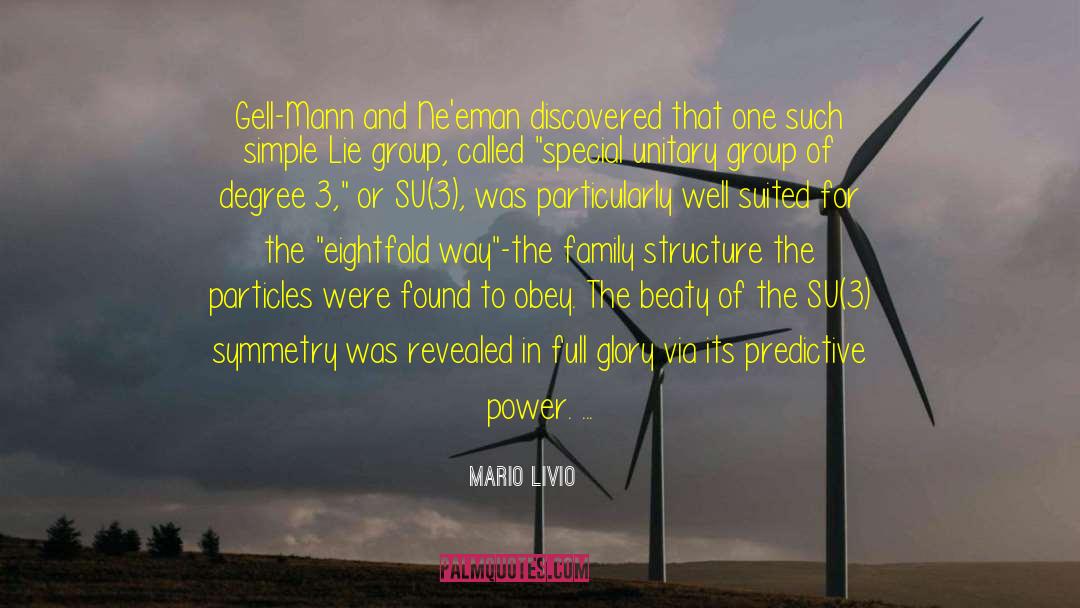Quotes About Livio Felluga
Enjoy collection of 41 Livio Felluga quotes. Download and share images of famous quotes about Livio Felluga. Righ click to see and save pictures of Livio Felluga quotes that you can use as your wallpaper for free.
Jacques was so impressed with the beauty of the curve known as a logarithmic spiral (Figure 37; the name was derived from the way in which the radius grows as we move around the curve clockwise) that he asked that this shape, and the motto he assigned to it: "Eadem mutato resurgo" (although changed, I rise again the same), be engraved on his tombstone.
The motto describes a fundamental property unique to the logarithmic spiral-it does not alter its shape as its size increases. This feature is known as self-similarity. Fascinated by this property, Jacques wrote that the logarithmic spiral "may be used as a symbol, either of fortitude and constancy in adversity, or of the human body, which after all its changes, even after death, will be restored to its exact and perfect self. ~ Mario Livio
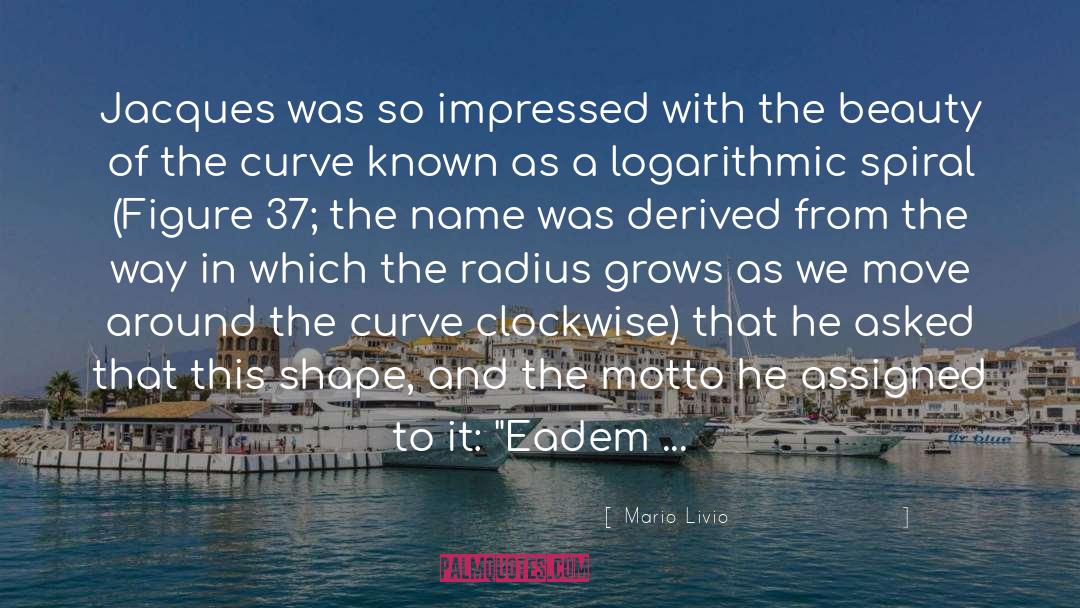
This was undoubtedly one of symmetry's greatest success stories. Glashow, Wienberg, and Salam managed to unmask the electromagnetic and weak forces by recognizing that underneath the differences in the strengths of these two forces (the electromagnetic force is about a hundred thousand times stronger within the nucleus) and the different masses of the messenger particles lay a remarkable symmetry. The forces of nature take the same form if electrons are interchanged with neutrinos or with any mixture of the two. The same is true when photons are interchanged with the W and Z force-messengers. The symmetry persists even if the mixtures vary from place to place or from time to time. The invariance of the laws under such transformations performed locally in space and time has become known as gauge symmetry. In the professional jargon, a gauge transformation represents a freedom in formulating the theory that has no directly observable effects-in other words, a transformation to which the physical interpretation is insensitive. Just as the symmetry of the laws of nature under any change of the spacetime coordinates requires the existence of gravity, the gauge symmetry between electrons and neutrinos requires the existence of the photons and the W and Z messenger particles. Once again, when the symmetry is put first, the laws practically write themselves. A similar phenomenon, with symmetry dictating the presence of new particle fields, repeats itself with the strong nuclear force ~ Mario Livio
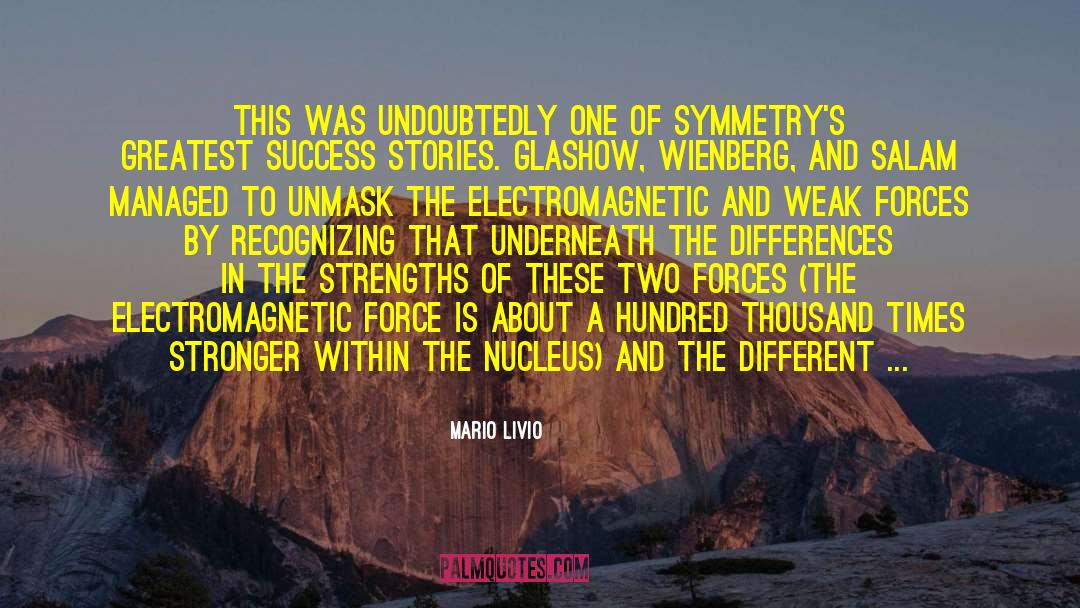
Mind-boggling, isn't it? Centuries before the question of why mathematics was so effective in explaining nature was even asked, Galileo thought he already knew the answer! To him, mathematics was simply the language of the universe. To understand the universe, he argued, one must speak this language. God is indeed a mathematician. ~ Mario Livio
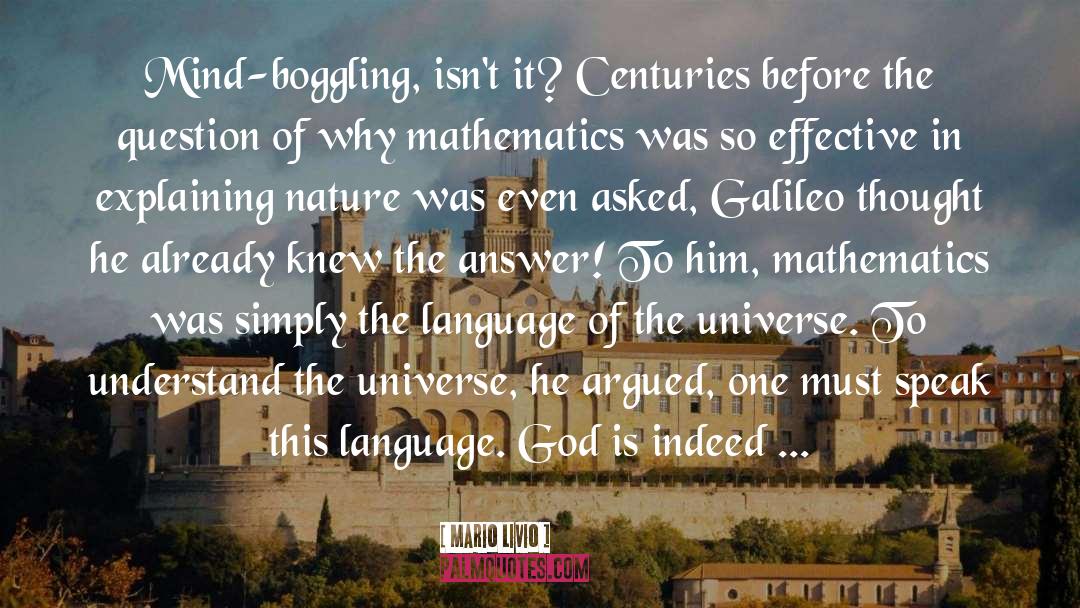
Tolerance of ambiguity is a necessary condition for creativity. ~ Mario Livio
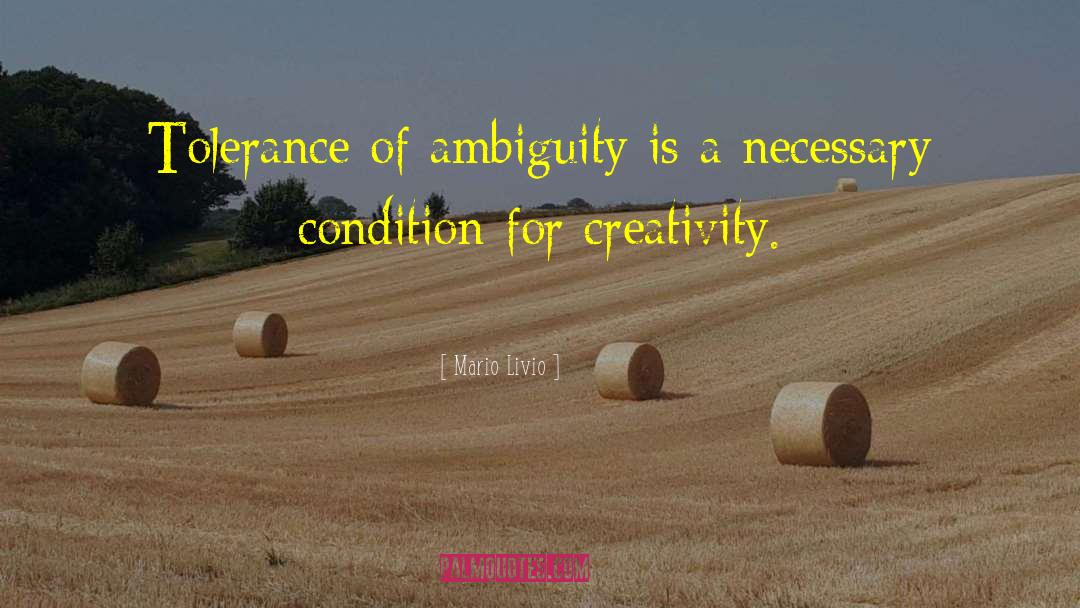
Twentieth-century British mathematician G.H. Hardy also believed that the human function is to "discover or observe" mathematics rather than to invent it. In other words, the abstract landscape of mathematics was there, waiting for mathematical explorers to reveal it. ~ Mario Livio
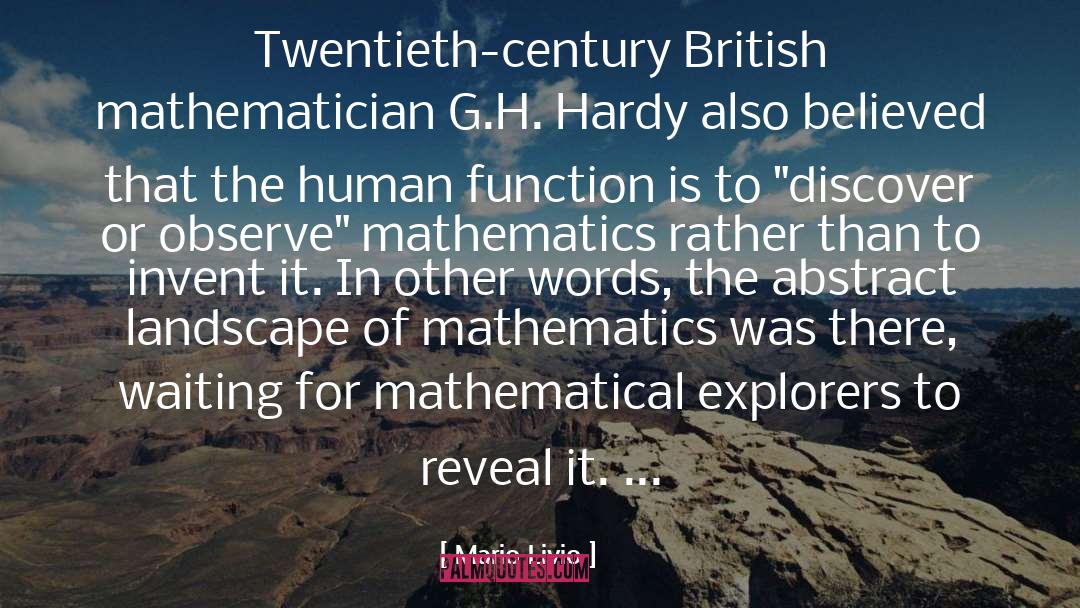
Nature loves logarithmic spirals. From sunflowers, seashells, and whirlpools, to hurricanes and giant spiral galaxies, it seems that nature chose this marvelous shape as its favorite "ornament." The constant shape of the logarithmic spiral on all size scales reveals itself beautifully in nature in the shapes of minuscule fossils or unicellular organisms known as foraminifera. Although the spiral shells in this care are composite structures (and not one continuous tube), X-ray images of the internal structure of these fossils show that the shape of the logarithmic spiral remained essentially unchanged for millions of years. ~ Mario Livio

Here, however, is where his genius truly took off. Galois managed to associate with each equation a sort of "genetic code" of that equation-the Galois group of the equation-and to demonstrate that the properties of the Galois group determine whether the equation is solvable by a formula or not. Symmetry became the key concept, and the Galois group was a direct measure of the symmetry properties of an equation. ~ Mario Livio
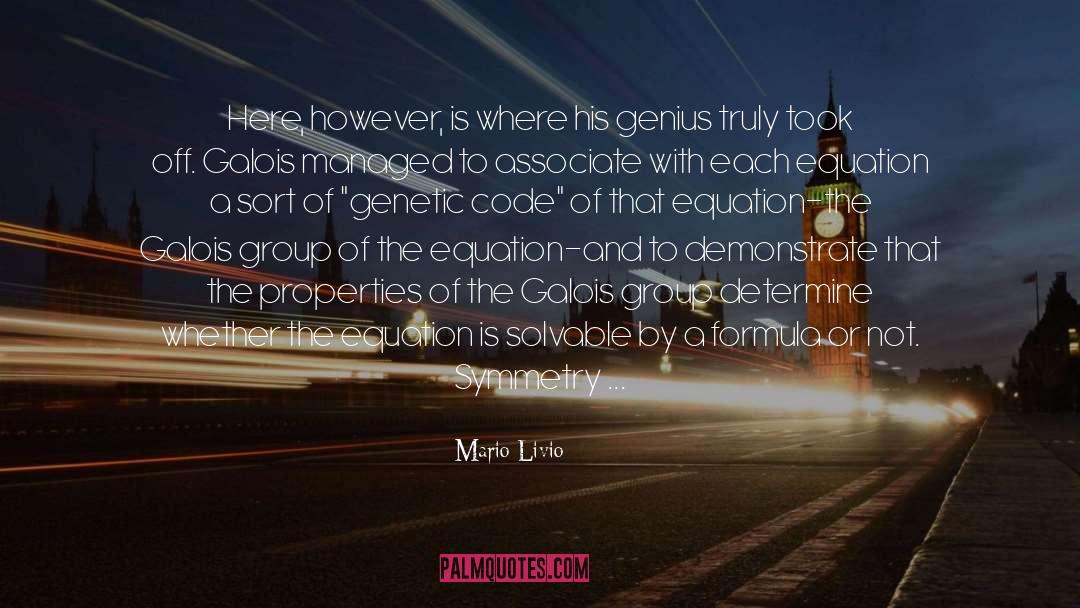
Group theory has been called by the noted mathematics scholar James R. Newman "the supreme art of mathematical abstraction." It derives its incredible power from the intellectual flexibility afforded by its definition. ~ Mario Livio
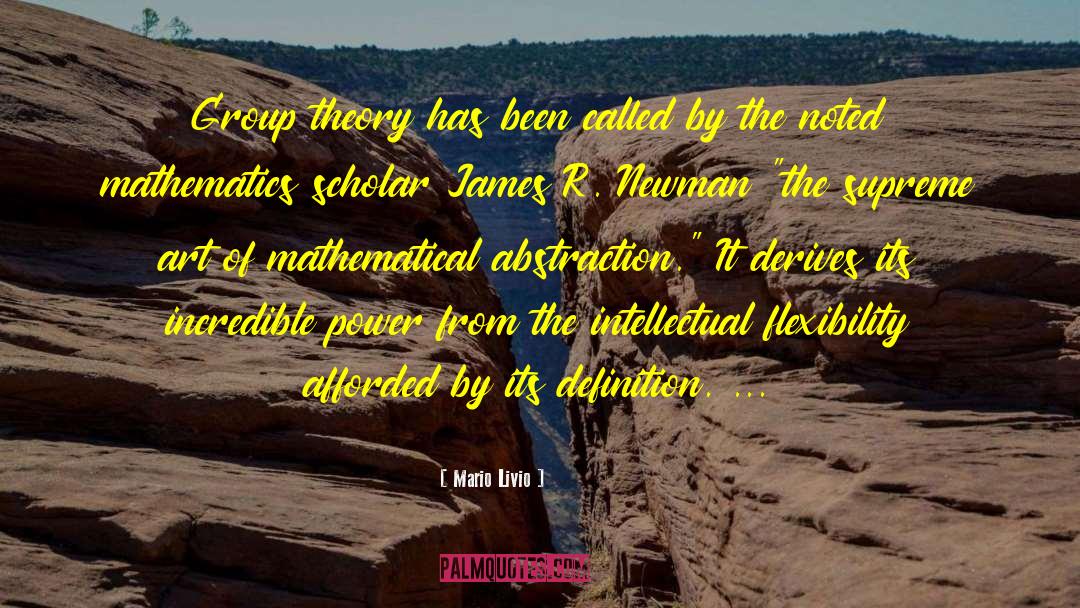
In his book Opticks, Newton made it clear that he did not believe that the laws of nature by themselves were sufficient to explain the universe's existence-God was the creator and sustainer of all the atoms that make up the cosmic matter: "For it became him [God] who created them [the atoms] to set them in order. And if he did so, it's unphilosophical to seek for any other Origin of the World, or to pretend that it might arise out of a Chaos by the mere Laws of Nature." In other words, to Newton, God was a mathematician (among other things), not just as a figure of speech, but almost literally-the Creator God brought into existence a physical world that was governed by mathematical laws. ~ Mario Livio
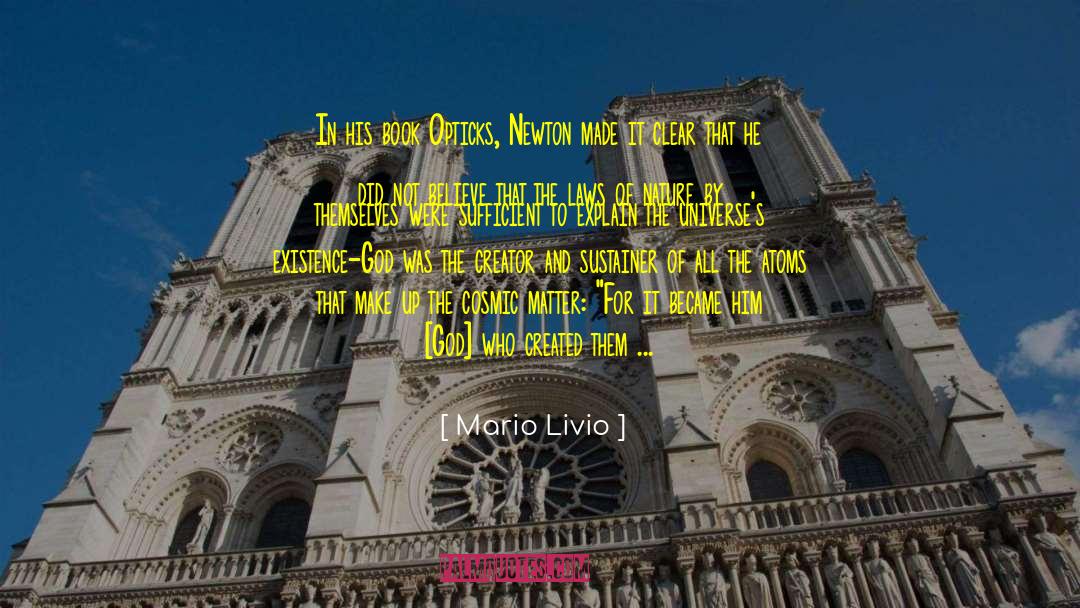
Indeed, the quality that made Newton's theories truly stand out-the inherent characteristic that turned them into inevitable laws of nature-was precisely the fact that they were all expressed as crystal-clear, self-consistent mathematical relations. ~ Mario Livio
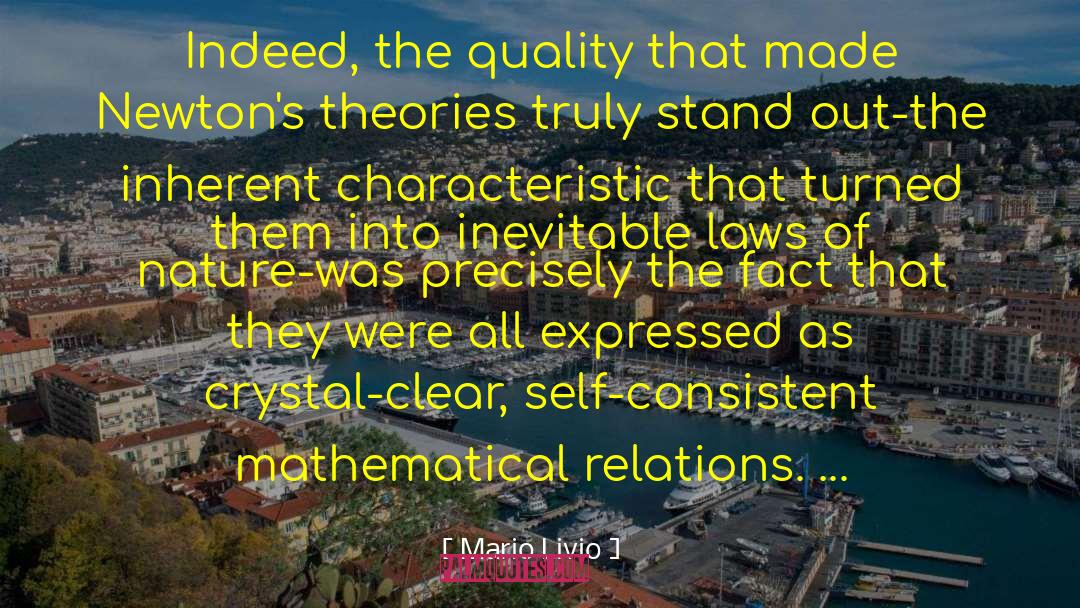
Some ancient Indian texts claim that numbers are almost divine, or "Brahma-natured. ~ Mario Livio

What can we conclude from all of these insights in terms of the role of symmetry in the cosmic tapestry? My humble personal summary is that we don't know yet whether symmetry will turn out to be the most fundamental concept in the workings of the universe. Some of the symmetries physicists have discovered or discussed over the years have later been recognized as being accidental or only approximate. Other symmetries, such as general covariance in general relativity and the gauge symmetries of the standard model, became the buds from which forces and new particles bloomed. All in all, there is absolutely no doubt in my mind that symmetry principles almost always tells us something important, and they may provide the most valuable clues and insights toward unveiling and deciphering the underlying principles of the universe, whatever those may be. Symmetry, in this sense, is indeed fruitful. ~ Mario Livio
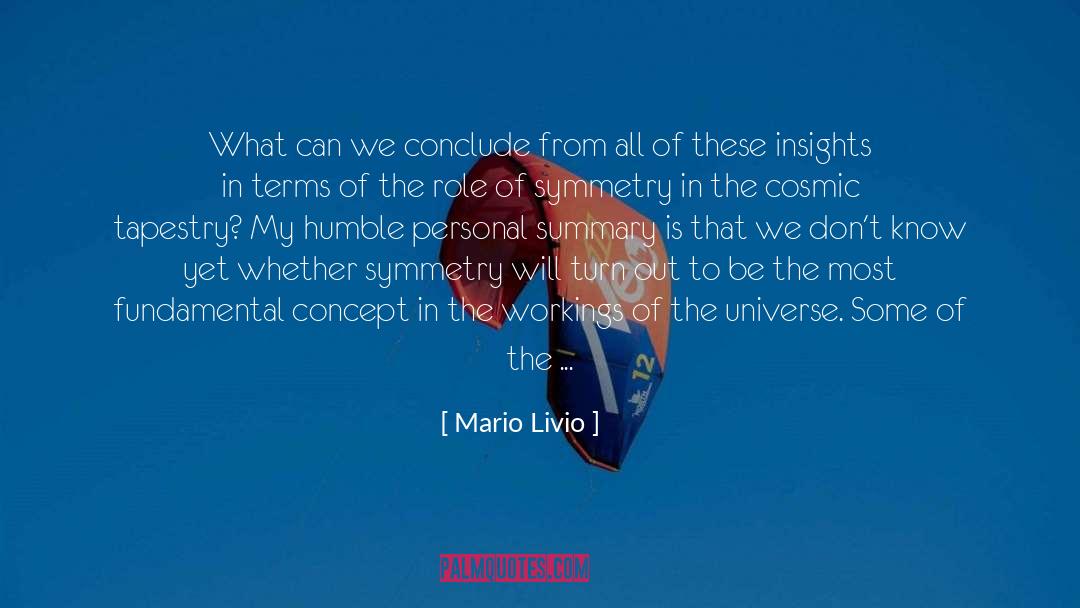
One of the string theory pioneers, the Italian physicist Daniele Amati, characterized it as "part of the 21st century that fell by chance into the 20th century." Indeed, there is something about the very nature of the theory at present that points to the fact that we are witnessing the theory's baby steps. Recall the lesson learned from all the great ideas since Einstein's relativity-put the symmetry first. Symmetry originates the forces. The equivalence principle-the expectation that all observers, irrespective of their motions, would deduce the same laws-requires the existence of gravity. The gauge symmetries-the fact that the laws do not distinguish color, or electrons from neutrinos-dictate the existence of the messengers of the strong and electroweak forces. Yet supersymmetry is an output of string theory, a consequence of its structure rather than a source for its existence. What does this mean? Many string theorists believe that some underlying grander principle, which will necessitate the existence of string theory, is still to be found. If history is to repeat itself, then this principle may turn out to involve an all-encompassing and even more compelling symmetry, but at the moment no one has a clue what this principle might be. Since, however, we are only at the beginning of the twenty-first century, Amati's characterization may still turn out to be an astonishing prophecy. ~ Mario Livio
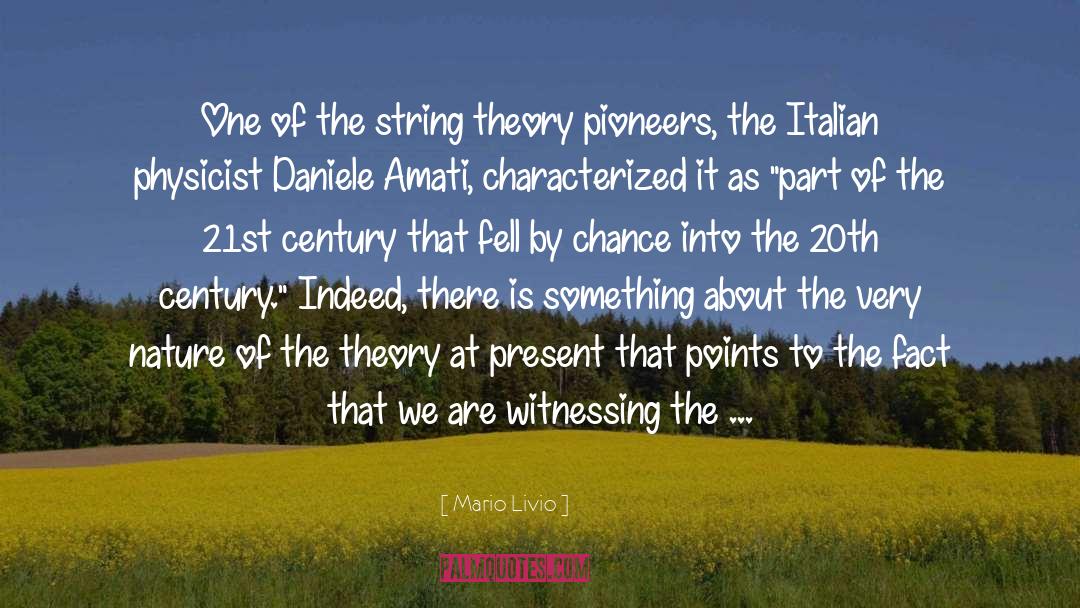
This development had dramatic philosophical consequences. As in the case of the non-Euclidean geometries in the nineteenth century, there wasn't just one definitive set theory, but rather at least four! One could make different assumptions about infinite sets and end up with mutually exclusive set theories. For instance, once could assume that both the axiom of choice and the continuum hypothesis hold true and obtain one version, or that both do not hold, and obtain an entirely different theory. Similarly, assuming the validity of one of the two axioms and the negation of the other would have led to yet two other set theories.
This was the non-Euclidean crisis revisited, only worse. The fundamental role of set theory as the potential basis for the whole of mathematics made the problem for the Platonists much more acute. If indeed one could formulate many set theories simply by choosing a different collection of axioms, didn't this argue for mathematics being nothing but a human invention? The formalists' victory looked virtually assured. ~ Mario Livio
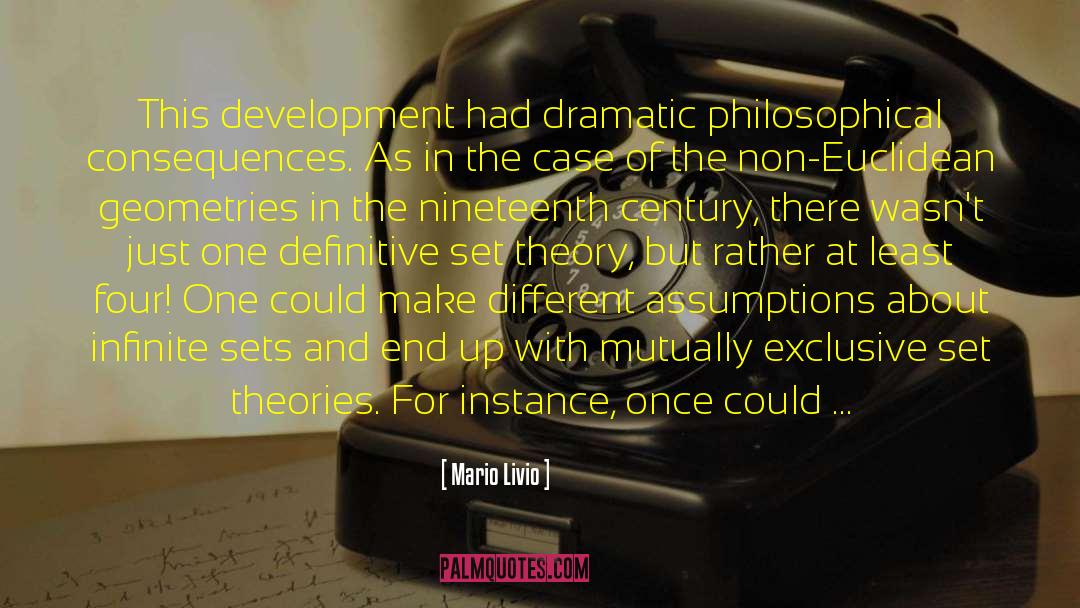
Moreover, Galileo argued that by pursuing science using the language of mechanical equilibrium and mathematics, humans could understand the divine mind. ~ Mario Livio
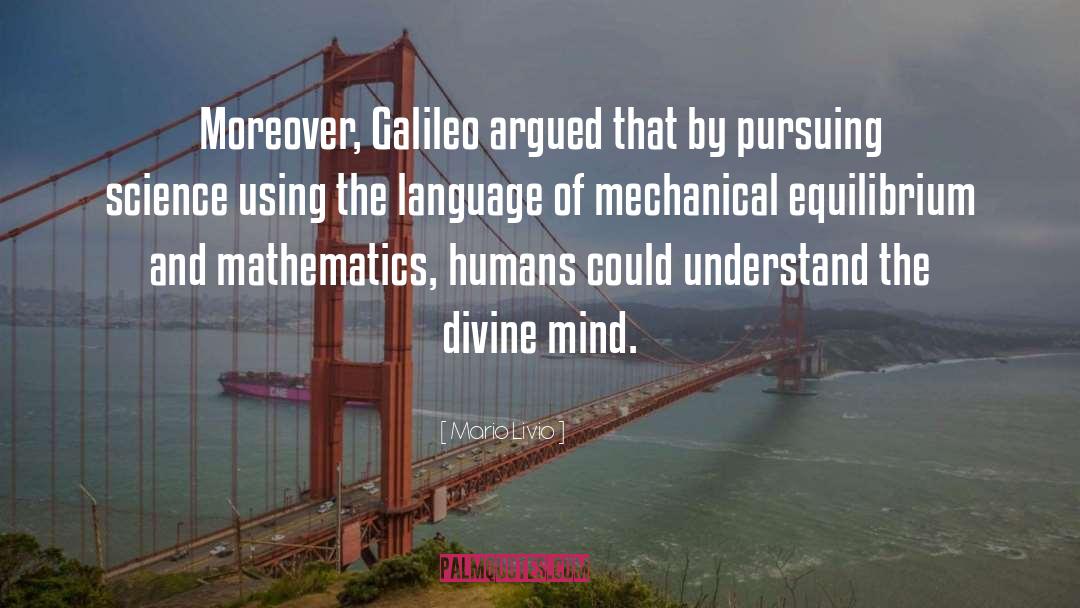
Some of the greatest mathematical minds of all ages, from Pythagoras and Euclid in ancient Greece, through the medieval Italian mathematician Leonardo of Pisa and the Renaissance astronomer Johannes Kepler, to present-day scientific figures such as Oxford physicist Roger Penrose, have spent endless hours over this simple ratio and its properties. But the fascination with the Golden Ratio is not confined just to mathematicians. Biologists, artists, musicians, historians, architects, psychologists, and even mystics have pondered and debated the basis of its ubiquity and appeal. In fact, it is probably fair to say that the Golden Ratio has inspired thinkers of all disciplines like no other number in the history of mathematics. ~ Mario Livio
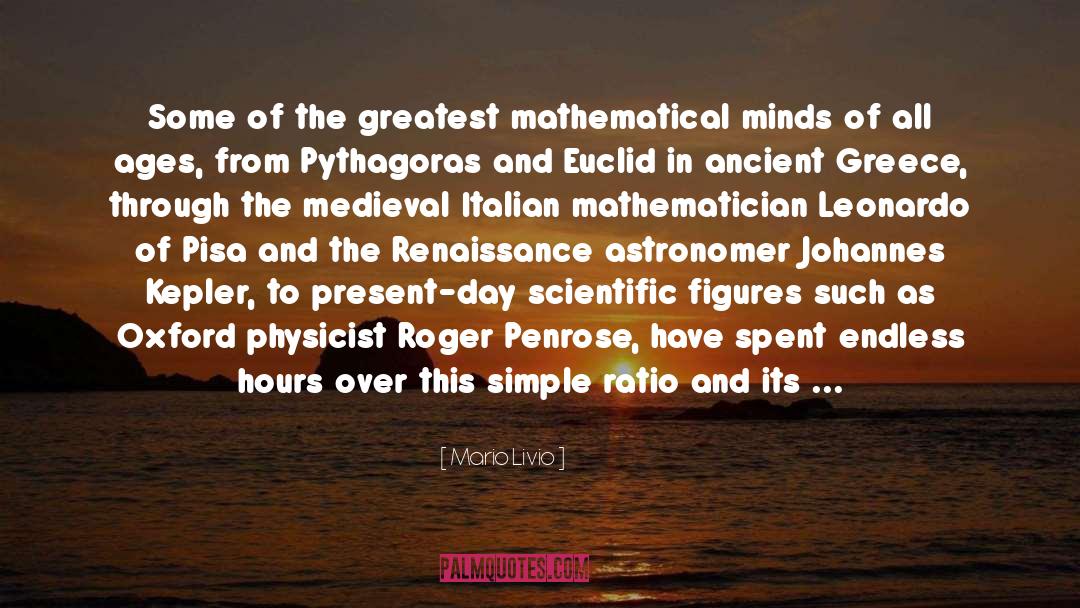
The Pythagoreans were probably the first to recognize the concept that the basic forces in the universe may be expressed through the language of mathematics. ~ Mario Livio
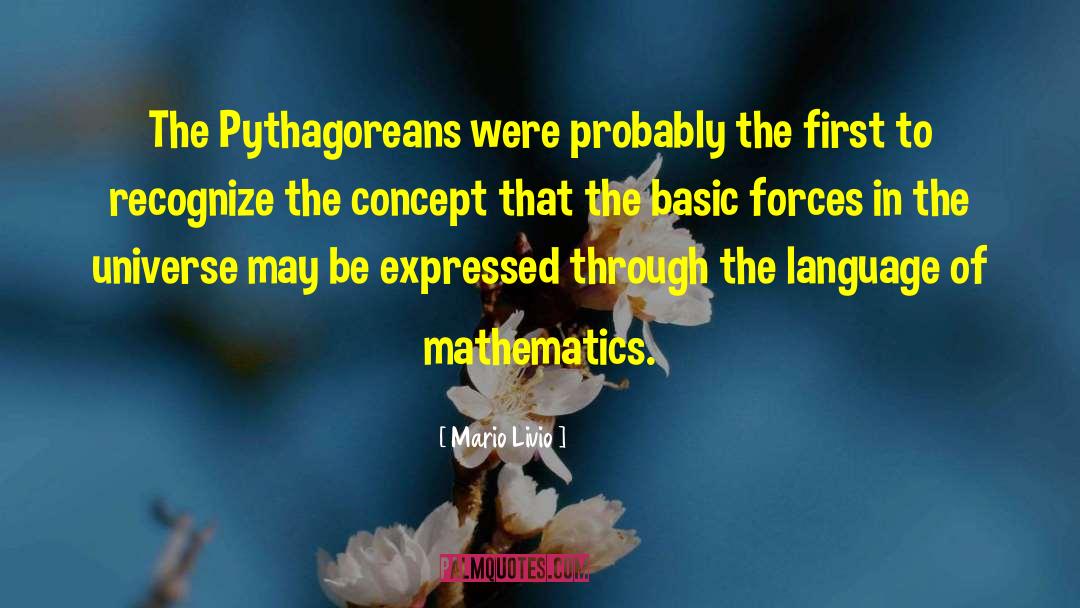
Even today, I am in total awe of the following wondrous chain of ideas and interconnections. Guided throughout by principles of symmetry, Einstein first showed that acceleration and gravity are really two sides of the same coin. He then expanded the concept to demonstrate that gravity merely reflects the geometry of spacetime. The instruments he used to develop the theory were Riemann's non-Euclidean geometries-precisely the same geometries used by Felix Klein to show that geometry is in fact a manifestation of group theory (because every geometry is defined by its symmetries-the objects it leaves unchanged). Isn't this amazing? ~ Mario Livio
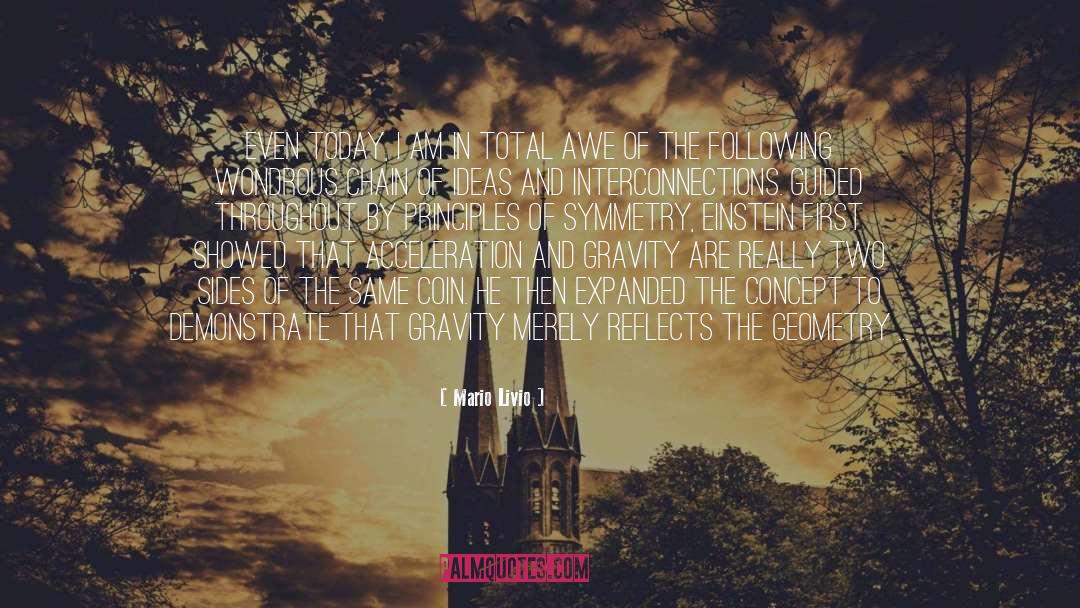
Imagine what would have happened had the logicist endeavor been entirely successful. This would have implied that mathematics stems fully from logic-literally from the laws of thought. But how could such a deductive science so marvelously fit natural phenomena? What is the relation between formal logic (maybe we should even say human formal logic) and the cosmos? The answer did not become any clearer after Hilbert and Godel. Now all that existed was an incomplete formal "game," expressed in mathematical language. How could models based on such an "unreliable" system produce deep insights about the universe and its workings? ~ Mario Livio
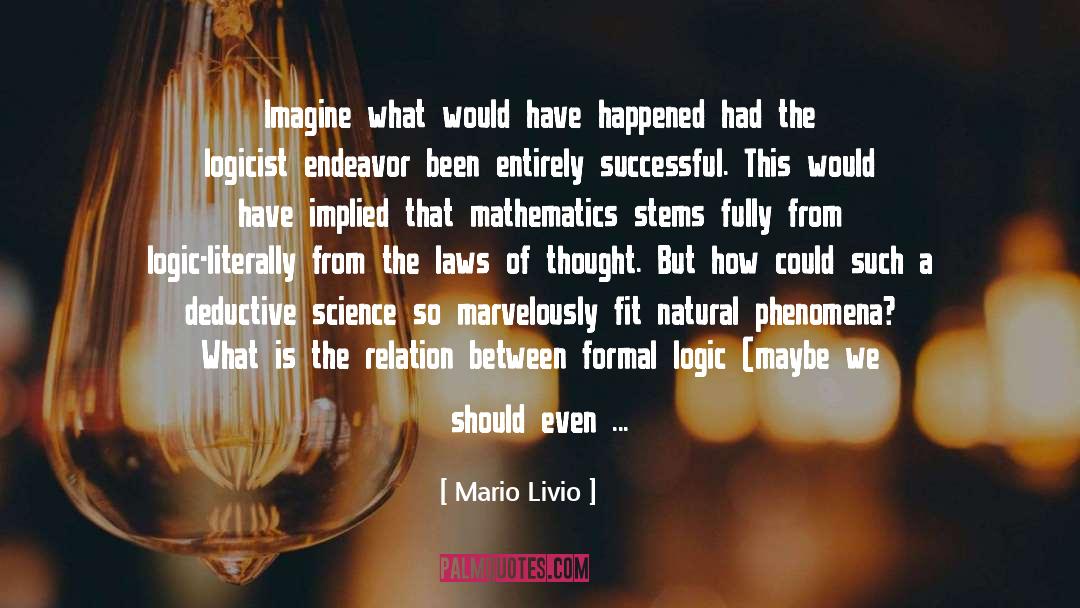
Noether's theorem fused together symmetries and conservation laws-these two giant pillars of physics are actually nothing but different facets of the same fundamental property. ~ Mario Livio
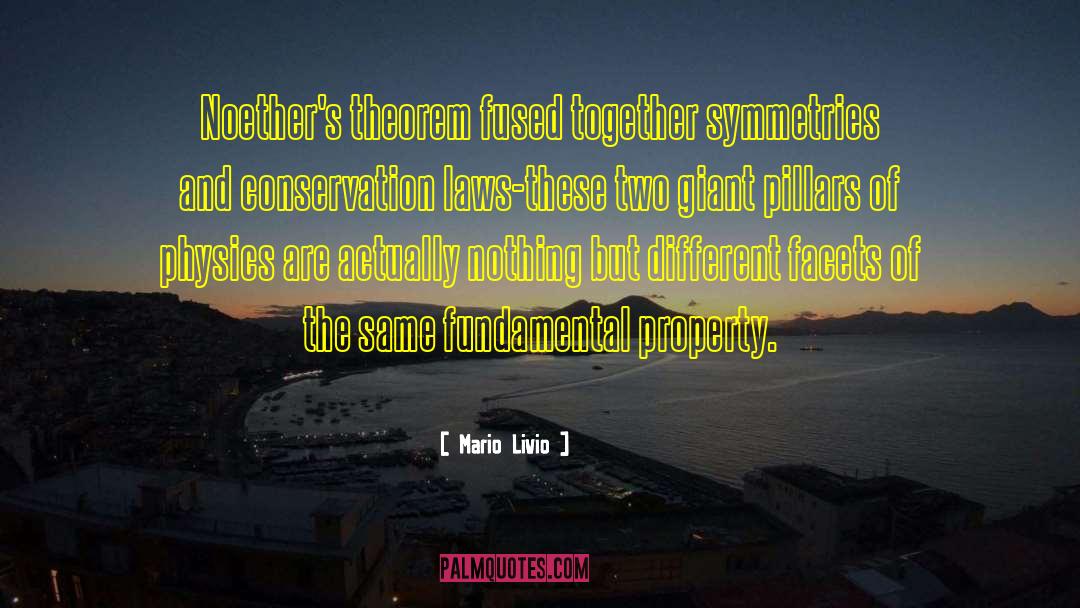
We have already seen that gauge symmetry that characterizes the electroweak force-the freedom to interchange electrons and neturinos-dictates the existence of the messenger electroweak fields (photon, W, and Z). Similarly, the gauge color symmetry requires the presence of eight gluon fields. The gluons are the messengers of the strong force that binds quarks together to form composite particles such as the proton. Incidentally, the color "charges" of the three quarks that make up a proton or a neutron are all different (red, blue, green), and they add up to give zero color charge or "white" (equivalent to being electrically neutral in electromagnetism). Since color symmetry is at the base of the gluon-mediated force between quarks, the theory of these forces has become known as quantum chromodynamics. The marriage of the electroweak theory (which describes the electromagnetic and weak forces) with quantum chromodynamics (which describes the strong force) produced the standard model-the basic theory of elementary particles and the physical laws that govern them. ~ Mario Livio
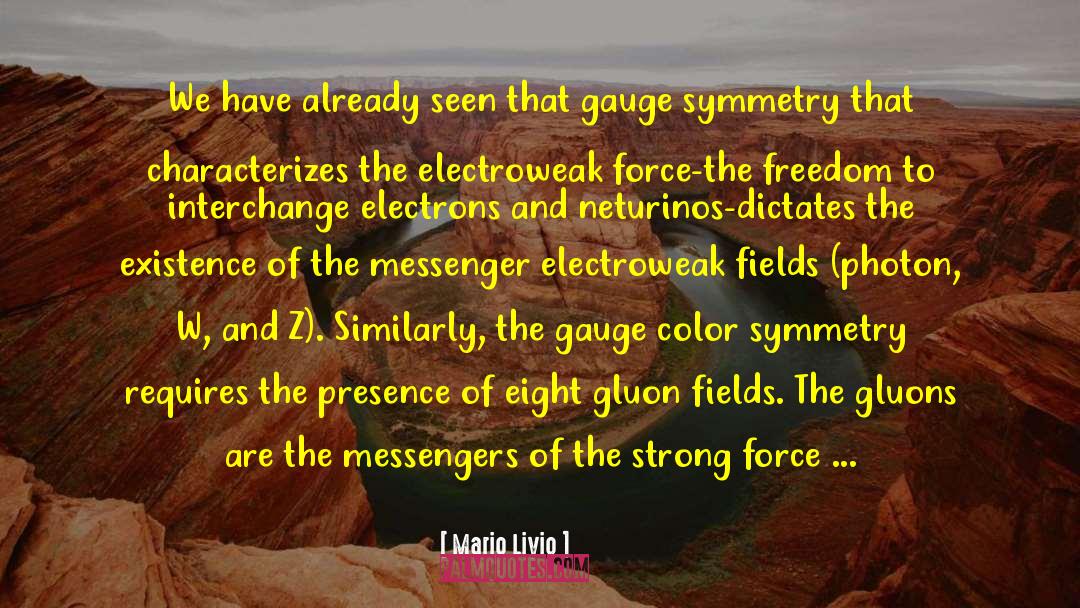
The legendary inscription above the Academy's door speaks loudly about Plato's attitude toward mathematics. In fact, most of the significant mathematical research of the fourth century BC was carried out by people associated in one way or another with the Academy. Yet Plato himself was not a mathematician of great technical dexterity, and his direct contributions to mathematical knowledge were probably minimal. Rather, he was an enthusiastic spectator, a motivating source of challenge, an intelligent critic, an an inspiring guide. The first century philosopher and historian Philodemus paints a clear picture: "At that time great progress was seen in mathematics, with Plato serving as the general architect setting out problems, and the mathematicians investigating them earnestly." To which the Neoplatonic philosopher and mathematician Proclus adds: "Plato...greatly advanced mathematics in general and geometry in particular because of his zeal for these studies. It is well known that his writings are thickly sprinkled with mathematical terms and that he everywhere tries to arouse admiration for mathematics among students of philosophy." In other words, Plato, whose mathematical knowledge was broadly up to date, could converse with the mathematicians as an equal and as a problem presenter, even though his personal mathematical achievements were not significant. ~ Mario Livio

Accordingly, Pacioli's book also starts with a discussion of proportions in the human body, "since in the human body every sort of proportion and proportionality can be found, produced at the beck of the all-Highest through the inner mysteries of nature. ~ Mario Livio

Having witnessed in his own life much agony and the horrors of war, Kepler concluded that Earth really created two notes, mi for misery ("miseria" in Latin) and fa for famine ("fames" in Latin). In Kepler's words: "the Earth sings MI FA MI, so that even from the syllable you may guess that in this home of ours Misery and Famine hold sway. ~ Mario Livio

So, what is light? Is it a pure bombardment by particles (photons) or a pure wave? Really, it is neither. Light is a more complicated physical phenomenon than any single one of these concepts, which are based on classical physical models, can describe. To describe the propagation of light and to understand the phenomena like interference, we can and have to use the electromagnetic wave theory. When we want to discuss the interaction of light with elementary particles, however, we have to use the photon description. This picture, in which the particle and wave descriptions complement each other, has become known as the wave-particle duality. The modern quantum theory of light has unified the classical notions of waves and particles in the concept of probabilities. The electromagnetic field is represented by a wave function, which gives the probabilities of finding the field in certain modes. The photon is the energy associated with these modes. ~ Mario Livio

One of Lindon's amusing word-unit palindromes reads: "Girl, bathing on Bikini, eyeing boy, finds boy eyeing bikini on bathing girl." Other palindromes are symmetric with respect to back-to-front reading letter by letter-"Able was I ere I saw Elba" (attributed jokingly to Napoleon), or the title of a famous NOVA program: "A Man, a Plan, a Canal, Panama. ~ Mario Livio
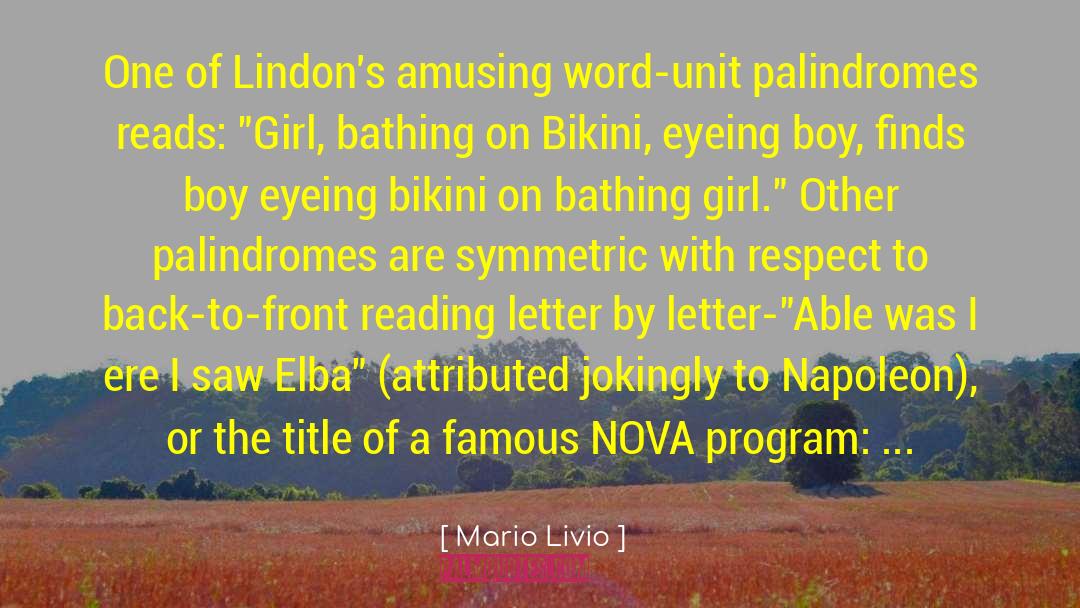
To claim that mathematics is purely a human invention and is successful in explaining nature only because of evolution and natural selection ignores some important facts in the nature of mathematics and in the history of theoretical models of the universe. First, while the mathematical rules (e.g., the axioms of geometry or of set theory) are indeed creations of the human mind, once those rules are specified, we lose our freedom. The definition of the Golden Ratio emerged originally from the axioms of Euclidean geometry; the definition of the Fibonacci sequence from the axioms of the theory of numbers. Yet the fact that the ratio of successive Fibonacci numbers converges to the Golden Ratio was imposed on us-humans had not choice in the matter. Therefore, mathematical objects, albeit imaginary, do have real properties. Second, the explanation of the unreasonable power of mathematics cannot be based entirely on evolution in the restricted sense. For example, when Newton proposed his theory of gravitation, the data that he was trying to explain were at best accurate to three significant figures. Yet his mathematical model for the force between any two masses in the universe achieved the incredible precision of better than one part in a million. Hence, that particular model was not forced on Newton by existing measurements of the motions of planets, nor did Newton force a natural phenomenon into a preexisting mathematical pattern. Furthermore, natural selection in the common int ~ Mario Livio
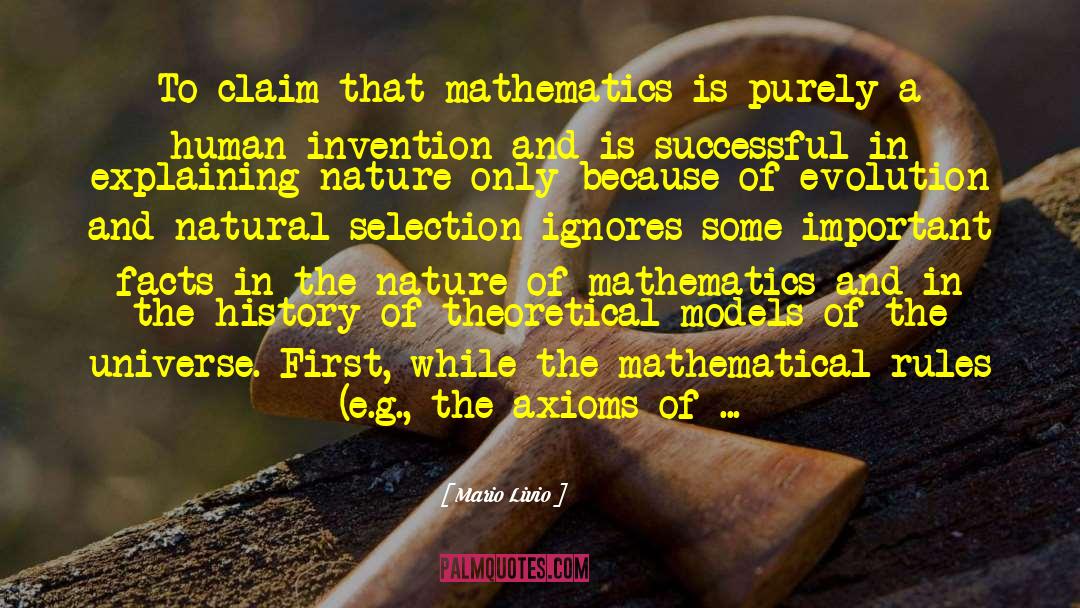
On the question of whether mathematics was discovered or invented, Pythagoras and the Pythagoreans had no doubt-mathematics was real, immutable, omnipresent, and more sublime than anything that could conceivably emerge from the feeble human mind. The Pythagoreans literally embedded the universe into mathematics. In fact, to the Pythagoreans, God was not a mathematician-mathematics was God!
The importance of the Pythagorean philosophy lies not only in its actual, intrinsic value. By setting the stage, and to some extent the agenda, for the next generation of philosophers-Plato in particular-the Pythagoreans established a commanding position in Western thought. ~ Mario Livio
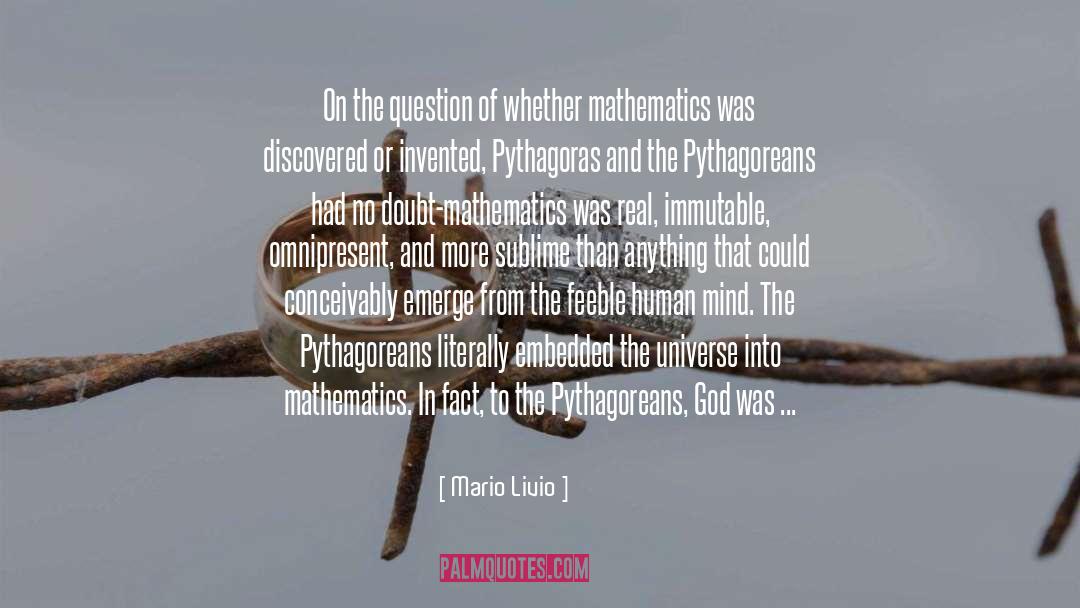
The beauty of the principle idea of string theory is that all the known elementary particles are supposed to represent merely different vibration modes of the same basic string. Just as a violin or a guitar string can be plucked to produce different harmonics, different vibrational patterns of a basic string correspond to distinct matter particles, such as electrons and quarks. The same applies to the force carriers as well. Messenger particles such as gluons or the W and Z owe their existence to yet other harmonics. Put simply, all the matter and force particles of the standard model are part of the repertoire that strings can play. Most impressively, however, a particular configuration of vibrating string was found to have properties that match precisely the graviton-the anticipated messenger of the gravitational force. This was the first time that the four basic forces of nature have been housed, if tentatively, under one roof. ~ Mario Livio

Based on these interviews, he compiled a list of ten dimensions of complexity-ten pairs of apparently antithetical characteristics that are often both present in the creative minds. The list includes:
1. Bursts of impulsiveness that punctuate periods of quiet and rest.
2. Being smart yet extremely naive.
3. Large amplitude swings between extreme responsibility and irresponsibility.
4. A rooted sense of reality together with a hefty dose of fantasy and imagination.
5. Alternating periods of introversion and extroversion.
6. Being simultaneously humble and proud.
7. Psychological androgyny-no clear adherence to gender role stereotyping.
8. Being rebellious and iconoclastic yet respectful to the domain of expertise and its history.
9. Being on one had passionate but on the other objective about one's own work.
10. Experiencing suffering and pain mingled with exhilaration and enjoyment. ~ Mario Livio

An interesting question is whether symmetry with respect to translation, and indeed reflection and rotation too, is limited to the visual arts, or may be exhibited by other artistic forms, such as pieces of music. Evidently, if we refer to the sounds, rather than to the layout of the written musical score, we would have to define symmetry operations in terms other than purely geometrical, just as we did in the case of the palindromes. Once we do that, however, the answer to the question, Can we find translation-symmetric music? is a resounding yes. As Russian crystal physicist G. V. Wulff wrote in 1908: "The spirit of music is rhythm. It consists of the regular, periodic repetition of parts of the musical composition...the regular repetition of identical parts in the whole constitutes the essence of symmetry." Indeed, the recurring themes that are so common in musical composition are the temporal equivalents of Morris's designs and symmetry under translation. Even more generally, compositions are often based on a fundamental motif introduced at the beginning and then undergoing various metamorphoses. ~ Mario Livio

While composite faces tend, by construction, to also be more symmetric, Langlois found that even after the effects of symmetry have been controlled, averageness was still judged to be attractive. These findings argue for a certain level of prototyping in the mind, since averageness might well be coupled with a prototypical template. ~ Mario Livio
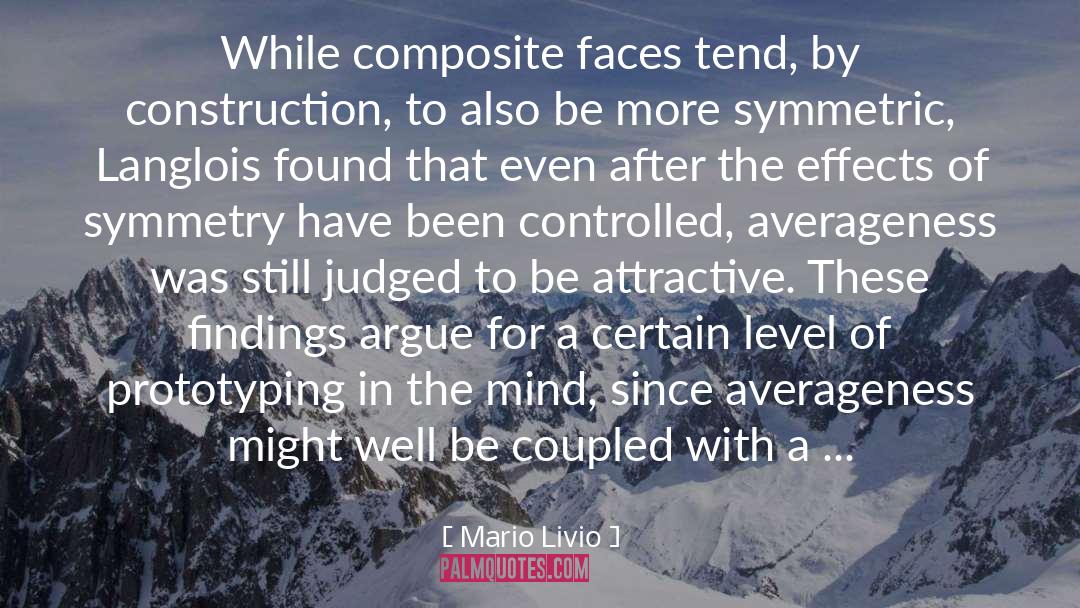
Galois's ideas, with all their brilliance, did not appear out of thin air. They addressed a problem whose roots could be traced all the way back to ancient Babylon. Still, the revolution that Galois had started grouped together entire domains that were previously unrelated. Much like the Cambrian explosion-that stunning burst of diversification in life forms on Earth-the abstraction of group theory opened windows into an infinity of truths. Fields as far apart as the laws of nature and music suddenly became mysteriously connected. The Tower of Babel of symmetries miraculously fused into a single language. ~ Mario Livio

No one, especially not Birkhoff himself, would claim that the intricacies of aesthetic pleasure could be reduced entirely to a mere formula. However, in Birkhoff's words, "In the inevitable analytic accompaniment of the creative process, the theory of aesthetic measure is capable of performing a double service: it gives a simple, unified account of the aesthetic experience, and it provides means for the systematic analysis of typical aesthetic fields. ~ Mario Livio

The number 6 was the first perfect number, and the number of creation. The adjective "perfect" was attached that are precisely equal to the sum of all the smaller numbers that divide into them, as 6=1+2+3. The next such number, incidentally, is 28=1+2+4+7+14, followed by 496=1+2+4+8+16+31+62+124+248; by the time we reach the ninth perfect number, it contains thirty-seven digits. Six is also the product of the first female number, 2, and the first masculine number, 3. The Hellenistic Jewish philosopher Philo Judaeus of Alexandria (ca. 20 B.C.-c.a. A.D. 40), whose work brought together Greek philosophy and Hebrew scriptures, suggested that God created the world in six days because six was a perfect number. The same idea was elaborated upon by St. Augustine (354-430) in The City of God: "Six is a number perfect in itself, and not because God created the world in six days; rather the contrary is true: God created the world in six days because this number is perfect, and it would remain perfect, even if the work of the six days did not exist." Some commentators of the Bible regarded 28 also as a basic number of the Supreme Architect, pointing to the 28 days of the lunar cycle. The fascination with perfect numbers penetrated even into Judaism, and their study was advocated in the twelfth century by Rabbi Yosef ben Yehudah Ankin in his book, Healing of the Souls. ~ Mario Livio
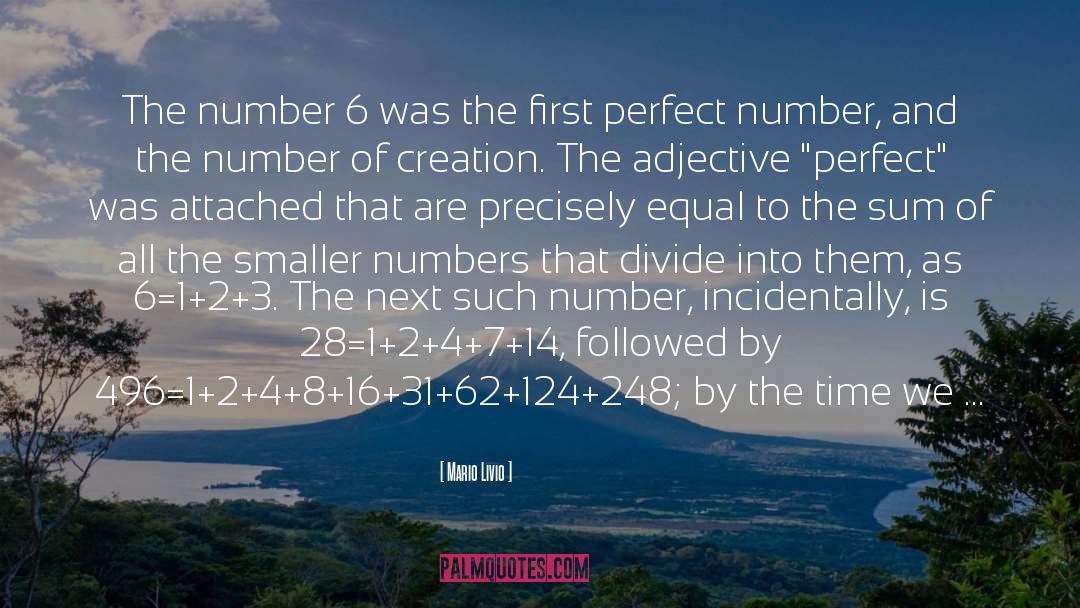
In the late 1960's, physicists Steven Weinberg, Abdus Salam, and Sheldon Glashow conquered the next unification frontier. In a phenomenal piece of scientific work they showed that the electromagnetic and weak nuclear forces are nothing but different aspects of the same force, subsequently dubbed the electroweak force. The predictions of the new theory were dramatic. The electromagnetic force is produced when electrically charged particles exchange between them bundles of energy called photons. The photon is therefore the messenger of electromagnetism. The electroweak theory predicted the existence of close siblings to the photon, which play the messenger role for the weak force. These never-before-seen particles were prefigured to be about ninety times more massive than the proton and to come in both an electrically charged (called W) and a neutral (called Z) variety. Experiments performed at the European consortium for nuclear research in Geneva (known as CERN for Conseil Europeen pour la Recherche Nucleaire) discovered the W and Z particles in 1983 and 1984 respectively. ~ Mario Livio

For Newton, the world's very existence and the mathematical regularity of the observed cosmos were evidence for God's presence. ~ Mario Livio
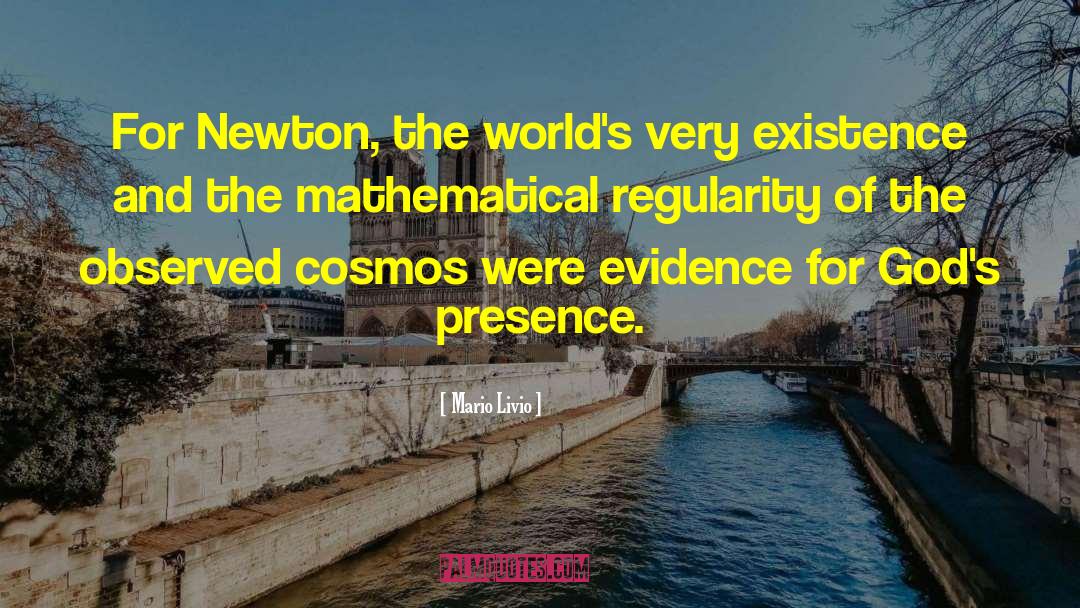
Is it odd how asymmetrical
Is "symmetry"?
"Symmetry" is asymmetrical.
How odd it is.
This stanza remains unchanged if read word by word from the end to the beginning-it is symmetrical with respect to backward reading. ~ Mario Livio
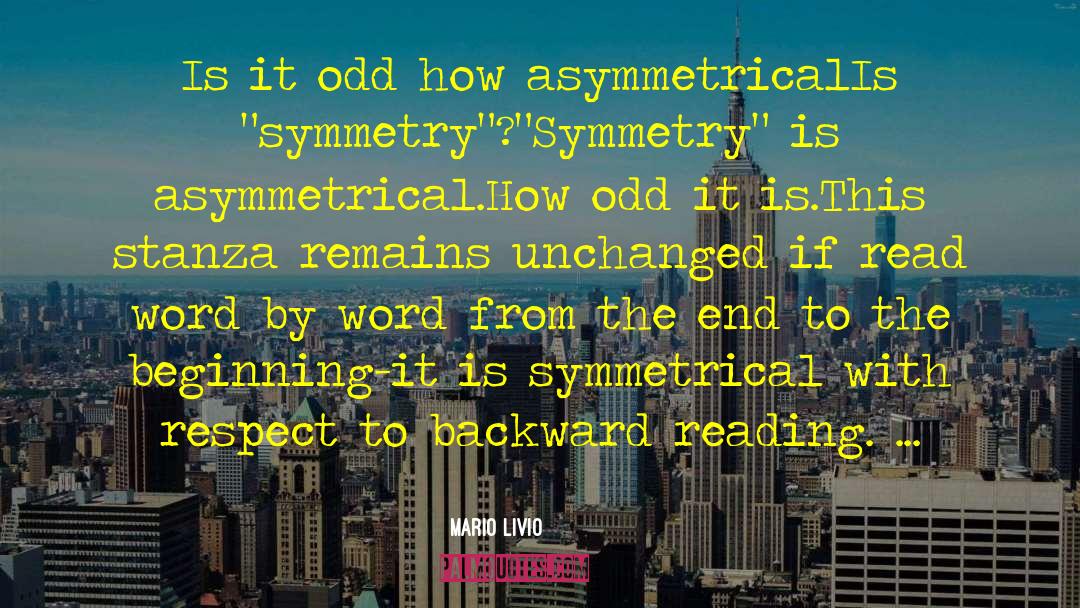
The two solutions of the equation for the Golden Ratio are:
x1 = (1+ Sqr5) / 2
x2 = (1 - Sqr5) / 2 ~ Mario Livio
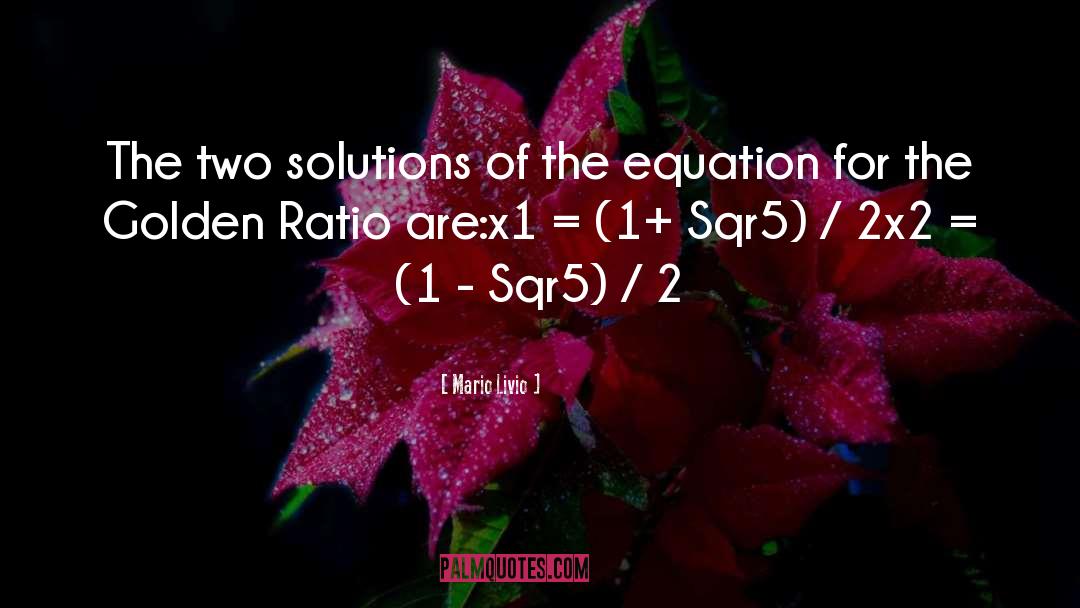
Because of the "divine" properties attributed to the Golden Ratio, mathematician Clifford A. Pickover suggested that we should refer to that point as "the Eye of God. ~ Mario Livio
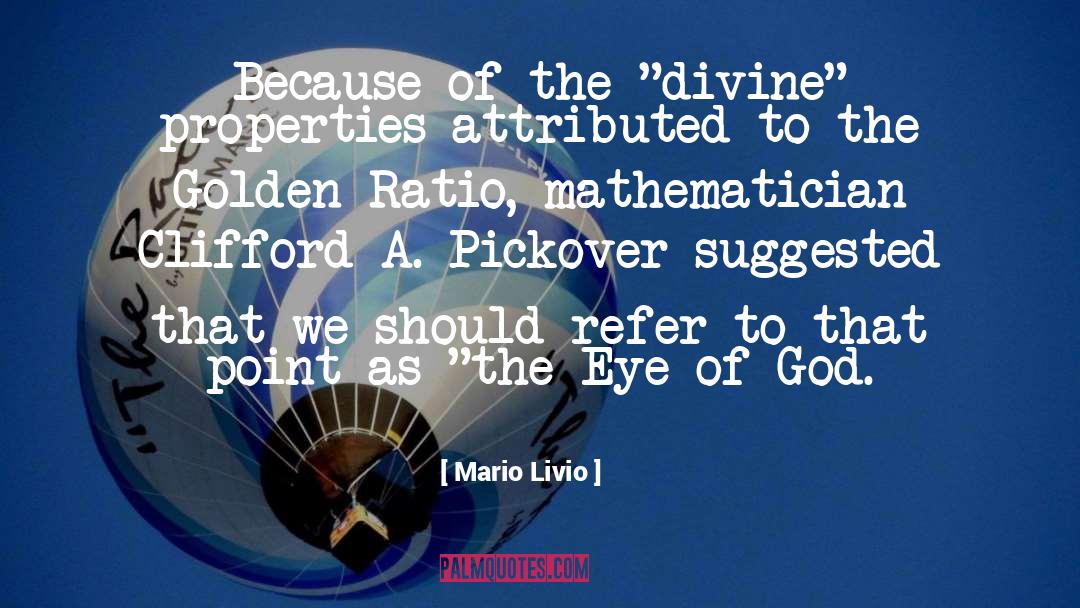
Gell-Mann and Ne'eman discovered that one such simple Lie group, called "special unitary group of degree 3," or SU(3), was particularly well suited for the "eightfold way"-the family structure the particles were found to obey. The beaty of the SU(3) symmetry was revealed in full glory via its predictive power. Gell-Mann and Ne'eman showed that if the theory were to hold true, a previously unknown tenth member of a particular family of nine particles had to be found. The extensive hunt for the missing particle was conducted in an accelerator experiment in 1964 at Brookhaven National Lab on Long Island. Yuval Ne'eman told me some years later that, upon hearing that half of the data had already been scrutinized without discovering the anticipated particle, he was contemplating leaving physics altogether. Symmetry triumphed at the end-the missing particle (called the omega minus) was found, and it had precisely the properties predicted by the theory. ~ Mario Livio
